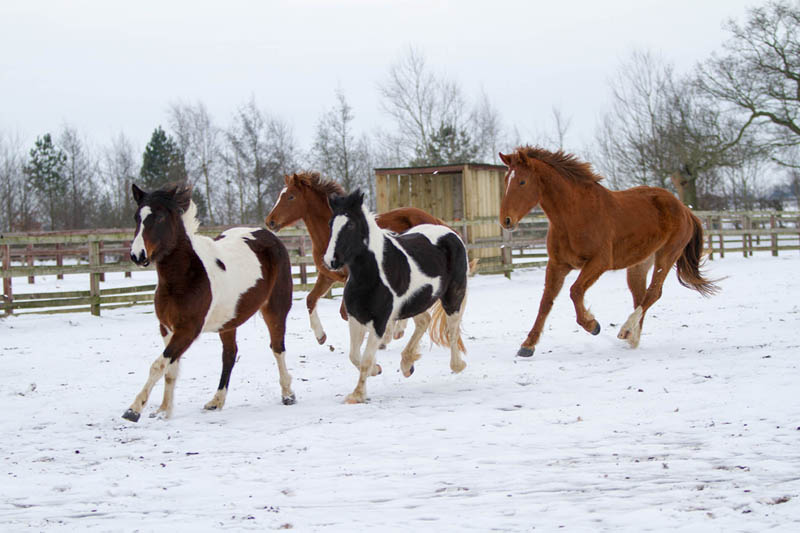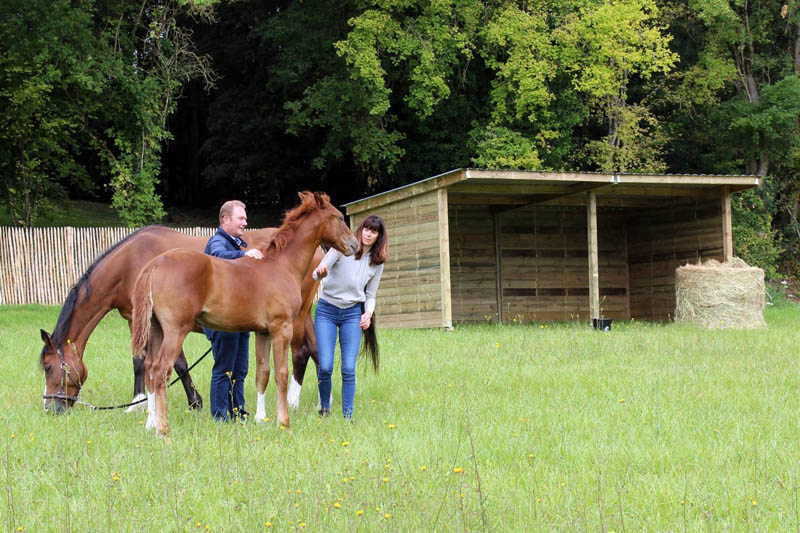Horses generally benefit from having access to a paddock shelter, which can provide them with protection from the elements and a place to rest. A paddock shelter should be large enough for the horse to comfortably move around in and should be located in a well-drained area to prevent mud and standing water. The shelter should also be properly ventilated to prevent the buildup of harmful gases and to keep the horse cool in hot weather. Additionally, the shelter should be cleaned regularly to maintain good hygiene and to prevent the buildup of parasites.
Static & Mobile Horse Shelters
Static horse shelters are permanent structures that are typically built on a concrete slab or a compacted gravel base. They are usually made of wood, metal, or a combination of both materials. They can be open-fronted or fully enclosed and can be used to provide protection from the elements, such as rain and wind, and a place for the horse to rest.
Mobile horse shelters, on the other hand, are structures that can be easily moved from one location to another. These shelters are typically made of canvas or synthetic material and are mounted on a frame that is supported by wheels or skids. They can be used for temporary or seasonal housing, or for traveling with horses. Mobile horse shelters are less expensive than static horse shelters, but may not be as durable and may not provide as much protection from the elements.
Both types of horse shelters are important to have in your barn or property, it depends on the size of the herd and the purpose of the barn.

Winter horse care tips
Here are some winter horse care tips to keep your horse healthy and comfortable during the colder months:
- Provide adequate shelter: Make sure your horse has access to a warm, dry shelter to protect them from the wind, rain, and snow. The shelter should be well-ventilated to prevent the buildup of harmful gases and to keep the horse cool in hot weather.
- Keep your horse warm: Make sure your horse is properly blanketed to protect them from the cold. Use a waterproof and breathable blanket to protect against wet and windy weather. Additionally, consider using a high-quality saddle pad to provide extra warmth and comfort during colder months. A huge collection of LeMieux saddle pads offers various options designed to keep your horse cozy while riding, with features like fleece lining and thermal properties.
- Provide enough food: During the winter, horses require more calories to maintain their body temperature and to support their immune system. Provide your horse with enough hay or haylage to meet their dietary needs.
- Keep the water flowing: Make sure your horse has access to fresh, unfrozen water at all times. Use a heater or insulate the water trough to prevent the water from freezing.
- Keep your horse active: Regular exercise is important for maintaining your horse’s health and fitness, even during the winter. Try to provide your horse with regular turnout, even if it’s just for a short time each day.
- Monitor your horse’s health: Keep an eye out for signs of illness or injury, such as lameness, weight loss, or a dull coat, and consult your veterinarian if you notice any issues.
- Keep the barn clean: Keep the barn and stall clean and dry, remove manure and wet bedding regularly, and ensure good ventilation to avoid respiratory issues.
- Keep an eye on the weather: Be aware of the weather forecast and take necessary precautions to protect your horse from extreme cold, wind, and snow.

5 Advantages of a Portable Run-In Shed
A portable run-in shed is a type of shelter that can be easily moved from one location to another. These sheds are typically made of a lightweight material, such as canvas or synthetic fabric, and are mounted on a frame that is supported by wheels or skids. They can be used for temporary or seasonal housing, or for traveling with horses. Portable run-in sheds are typically less expensive than permanent structures and are easy to set up and take down. They can provide your horse with protection from the elements such as rain, wind, and snow. Additionally, they can be used for a variety of purposes, such as temporary storage for hay or feed, or as a shelter for other animals such as sheep or goats.
- Flexibility: Portable run-in sheds can be moved from one location to another, allowing you to easily provide shelter for your horses in different areas of your property or even take it with you if you move.
- Cost-effective: Portable run-in sheds are generally less expensive than permanent structures, making them a cost-effective option for horse owners.
- Quick and easy to set up: Portable run-in sheds can be set up quickly and easily, without the need for any specialized equipment or a team of builders.
- Weather protection: Portable run-in sheds can provide your horse with protection from the elements such as rain, wind, and snow.
- Versatility: Portable run-in sheds can be used for a variety of purposes, such as temporary housing for horses, temporary storage for hay or feed, or as a shelter for other animals such as sheep or goats.
A portable run-in shed can be used to provide shelter for plants, like an orangerie. An orangerie is a type of greenhouse that is typically used to grow citrus fruits and other tropical plants.
A portable run-in shed can be set up in a sunny location and outfitted with shelves, grow lights, and other equipment to provide the necessary conditions for plant growth. The shelter can protect the plants from harsh weather conditions, such as frost, wind, and heavy rain, allowing them to grow and flourish even in colder climates.
It’s important to keep in mind that a portable run-in shed may not provide the same level of insulation and temperature control as a traditional greenhouse, so it may not be suitable for growing plants that require specific temperature and humidity levels. Additionally, proper ventilation must be provided to control the temperature and humidity inside the portable run-in shed to avoid any damage to the plants.

Correct method of securing a run-in shed
Securing a portable run-in shed properly is important to ensure that it stays in place and provides adequate shelter for your horse. Here are some steps to properly secure a portable run-in shed:
- Choose a level and stable location: Make sure the location you choose for the shed is level and stable, with good drainage. Avoid areas that are prone to flooding or erosion.
- Anchor the shed: Use anchors, such as ground stakes or earth anchors, to secure the shed to the ground. Make sure the anchors are driven deep enough into the ground to provide a secure hold.
- Use guy ropes or cables: Use guy ropes or cables to provide additional support and stability to the shed. Attach the ropes or cables to the corners and sides of the shed and anchor them to the ground.
- Use a tarp or cover: Use a tarp or cover to protect the shed from the elements. The tarp or cover should be securely fastened to the shed and anchored to the ground to prevent it from blowing away.
- Inspect the shed regularly: Inspect the shed regularly for any signs of wear or damage, and make any necessary repairs or adjustments to ensure that it stays secure and stable.
- It’s important to keep in mind that the method of securing the shed may vary depending on the type of portable run-in shed you have and the weather conditions in your area. Always follow the manufacturer’s instructions and guidelines for proper installation and maintenance.

